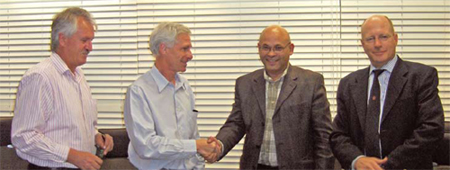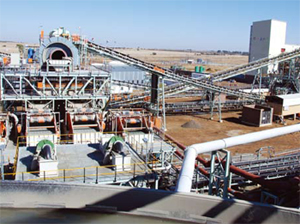|
MARCH 2009 |
 |
|
 |
| Home | | |
Message from CE | | |
Cover story | | |
Case study | | |
| |
People | | |
Awards | | |
CSI |
| Currently viewing: Case study / Next: Projects |
Case study
VOORSPOED ALLIANCE
Competent partners are a project`s best friend
 |
| Project completion. From left to right: Graham Mullany, FD Murray & Roberts Engineering Solutions; Frank Kruger, MD Murray & Roberts Engineering Solutions; Stephen Dietrich, FD DBCM and Mike Brown, CO DBCM |
In 2008, the Voorspoed diamond mine was completed by the De Beers/Murray & Roberts Alliance well ahead of schedule and below budget. How was this achieved in an environment of high inflation, delivery delays and scarce skilled human resources? Frank Kruger, MD of Murray & Roberts Engineering Solutions outlines the factors behind the success of the project. With the De Beers/Murray & Roberts Alliance, the client and the project implementer forged a partnership that delivered a successful diamond mine and significant value to both parties. The alliance, which included several Murray & Roberts companies in a unitary format, was core to the successful delivery of the project: De Beers, the world’s leading diamond miner, brought its extensive experience and the Voorspoed diamond resource to the alliance, while Murray & Roberts, South Africa’s leading engineering and construction group, contributed its project implementation experience.
| Aerial view of mine site showing old workings |
 |
Voorspoed is a mid-sized diamond mine in the Free State and is the first greenfields mine developed by De Beers in South Africa for over 15 years. The mine grades were not high and innovative thinking was required to cut the project capital and operating costs to prove viability. The capital implementation phase was delivered well under the voted amount and commissioned to the nameplate test criteria many months earlier than planned.
PARTNERING PHILOSOPHY
The sale by Anglo American of its shareholding in De Beers in 2002 had a direct impact on the capital project development capacity of De Beers, and precipitated a strategic review during which the ‘partnering philosophy’ was initiated. In line with this philosophy, De Beers sought service providers that could be alliance partners – parties who could be strategically aligned and who valued continual learning and long-term relationship building.
In 2003, Murray & Roberts was invited, with others, to participate in the development stages of this partnering philosophy. At the same time, a pre-feasibility study for Voorspoed diamond mine was let to Murray & Roberts Engineering Solutions.
By March 2005, a partnering agreement, the so called ‘organisation to organisation over-arching agreement’ covering projects in general was struck between De Beers and Murray & Roberts.
Voorspoed in the meantime, was taken to the level of feasibility study acceptance by October 2005, but the full project implementation was delayed for 12 months while De Beers obtained the New Order Mining Right for Voorspoed (the first to be issued to De Beers by the Department of Minerals and Energy).
The partnering philosophy was by now reflected in a project alliance agreement, founded on the alliance principles of Jim Ross, an expert and author in the field of alliancing, particularly in Australian public sector projects. Ross was employed as a consultant to De Beers.
Design and procurement work was completed in 2006, but momentum – and certain key resources – were lost as De Beers awaited the mining licence. In October 2006, the licence was attained and the project was finally given the green light.
PROJECT PERFORMANCE
Capital expenditure and the schedule were both well within the agreed targets, activating the payment of incentives to Murray & Roberts. This was a true win/win outcome for both parties. The close-out of the project after a successful performance test was within a month.
The lost time injury frequency rate was three per million hours worked which exceeded the agreed maximum key performance indicator, resulting in the deduction of a percentage of profits from Murray & Roberts.
At the close-out meeting of the project alliance board, the client acknowledged that the alliance model had been value adding for De Beers and that it had allowed the business to demonstrate superior project delivery.
The Voorspoed experience has positioned Murray & Roberts favourably for alliance projects – in fact, the delivery of engineering, procurement and construction (EPC) projects using the 7 n The constructed processing plant alliance model could be considered a differentiator in a competitive environment.
The Group is currently exploring further alliance opportunities.
ALLIANCING What is alliancing? In the early 1990s British Petroleum had to develop the North Sea oil reserves more cheaply for reasons of viability. This necessitated a departure from traditional competitive models. Companies were selected on merit not price, the books were open and the painshare and gainshare philosophy was born – behaviour had to change. After significant effort and game breaking innovation the Andrew well field was delivered six months early at £290 million versus the £450 million originally estimated. The news of this success spread to numerous industries around the world, including Australia, where Jim Ross has developed the concept further.
Furthermore:
Governance
MURRAY & ROBERTS IN A UNITARY DELIVERY CONFIGURATION
KEY LEARNING AREAS
|



